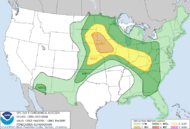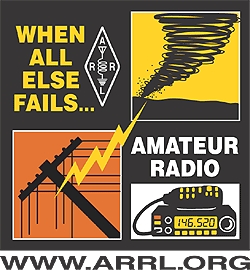Frequencies
Missouri Repeater Council Link
Area Repeaters
X = Yeasu System Fusion Wires-X available
XD1 = MMDVM Repeater, DMR and Fusion capable.
(DMR TS#1 NWMO TG31294 TS#2 BYRG TG
YSF Not linked to any room, Works just like WIRES-X just YSF rooms NOT WIRES-X.)
DMR = DMR repeater
L = NWNMO ARES affiliated repeaters and are linked 24/7, please allow a 1-2 second pause for all timers to reset.
| Repeater | Location | Frequency | Offset | PL Tone |
| WD0SKY | Osborn | 145.150 | - | 107.2 |
| KC0QLU | Plattsburg | 146.895XD1 | - | |
| KM0HP | Saint Joseph | 443.950DMR | + | |
| N0SWP | Osborn | 442.675 L | + | 127.3 |
| KØMPT | Chilicothe | 147.225 | + | none |
| WØNH | St. Joe | 146.850X | - | 100.0 |
| WD0BBR | Hamilton | 146.745 L | - | 141.3 |
| WINLINK | Cameron Hospital | 145.090 | kc0qlu-10 | |
| WINLINK | Hamilton | 145.090 | kc0yej-10 | |
| W0BYU | Kingston | 443.375X | + | 192.8 |
| N2OYJ | Bethany | 443.075 | + | 100.0 |
| N2OYJ | Rockport | 444.775 | + | 100.0 |
| WA0HBX | St. Joe | 444.925 | + | 100.0 |
| N0MIJ | Leavenworth | 442.350 | + | 107.2 |
| KD0ETV | Marceline | 443.150 | + | 110.9 |
| KB0RPJ | Trenton | 146.955 | - | none |
| KC0GP | Polo | 444.675 L | + | 151.4 |
| N0GGU | Maryville | 444.475 | + | 100.0 |
Missouri ARES Interoperability Tactical Frequencies
These frequencies are defined in the Missouri ARES interoperability plan. Their purpose is to create a group of frequencies for use statewide for emergency communications traffic. This allows for amateur radio operators who are using commercial equipment that is not frequency agile to have frequencies which will be used in an emergency pre-programmed. When using these frequencies, those frequencies indicated should be transmitted with the displayed pl tone. Receive squelch should remain carrier, unless interference requires the use of the pl tone. 6 meter and vhf frequencies are intended for regional and local operations respectively, with uhf frequencies intended for use as on-scene frequencies. While these are agreed upon frequencies for use during an emergency, other factors can play into the decision on which frequency to operate on, including existing infrastructure/repeaters in the area, geography, and other operations ongoing in the area of operations.
| Name | Frequency | Transmit PL | Primary MSHP Troop |
| HVCALL | 146.550 | CSQ | Statewide |
| HVSTAGE | 147.555 TSQ | 100.0 | Statewide |
| HVTAC0 | 147.495 | 100.0 | Statewide Digital Voice |
| HVTAC1 | 145.600 | 100.0 | Troop A |
| HVTAC2 | 145.650 | 100.0 | Troop B |
| HVTAC3 | 145.700 | 100.0 | Troop C |
| HVTAC4 | 146.400 | 100.0 | Troop D |
| HVTAC5 | 146.445 | 100.0 | Troop E |
| HVTAC6 | 146.505 | 100.0 | Troop F |
| HVTAC7 | 146.595 | 100.0 | Troop G |
| HVTAC8 | 147.405 | 100.0 | Troop H |
| HVTAC9 | 147.450 | 100.0 | Troop I |
| HUCALL | 446.000 | CSQ | Statewide |
| HUTAC1 | 445.900 | 100.0 | Statewide |
| HUTAC2 | 445.925 | 100.0 | Statewide |
| HUTAC3 | 445.950 | 100.0 | Statewide |
| HUTAC4 | 445.975 | 100.0 | Statewide |
| HUTAC5 | 446.025 | 100.0 | Statewide |
| HUTAC6 | 446.050 | 100.0 | Statewide |
| HUTAC7 | 446.075 | 100.0 | Statewide |
| HUTAC8 | 446.100 | 100.0 | Statewide |
| HMCALL | 52.550 | CSQ | Statewide |
| HMTAC0 | 52.710 | 100.0 | Statewide |
| HMTAC1 | 52.310 | 100.0 | Troop A |
| HMTAC2 | 52.350 | 100.0 | Troop B |
| HMTAC3 | 52.390 | 100.0 | Troop C |
| HMTAC4 | 52.430 | 100.0 | Troop D |
| HMTAC5 | 52.470 | 100.0 | Troop E |
| HMTAC6 | 52.510 | 100.0 | Troop F |
| HMTAC7 | 52.590 | 100.0 | Troop G |
| HMTAC8 | 52.630 | 100.0 | Troop H |
| HMTAC9 | 52.670 | 100.0 | Troop I |
To read the Missouri ARES Interoperability Plan in it’s entirety, follow this link: Missouri ARES Interoperability Plan
More useful info can be found in the Auxiliary Communications Field Operations Guide (AUXFOG)
HF Emergency Frequencies
| Frequency | Net |
| 3963.0 Khz | Missouri Emergency Services Net (MESN) Sunday’s 6:00pm |
| 3963.0 Khz | Missouri Traffic Net Daily 5:30pm |
| 7263.0 Khz | MESN Daytime Alternate Frequency |

